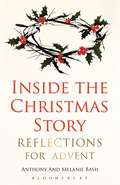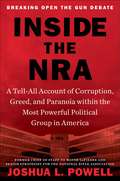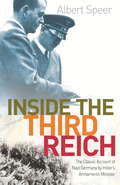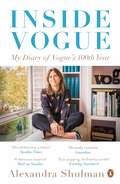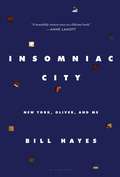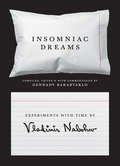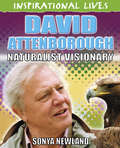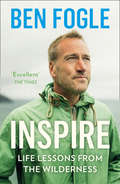- Table View
- List View
Inside the Christmas Story: Reflections for Advent
by Anthony Bash Melanie BashIf you are troubled by the loss of 'Christ' in 'Christmas'; and by the noise, pressure and materialism of secular Advent with its emphasis on material and commercial rather than spiritual preparation for Christmas, this book will help you to read and think about Advent and Christmas in a new way. Co-authored by a New Testament specialist and a practising clinical psychologist, it explores the familiar narratives from the Christmas story with freshness and vigour, and draws out their implications for day-to-day living. The Christmas story is full of themes that we often avoid in churches - asylum seekers and refugees; death; loss and suffering; old age; childlessness - but they can give a new depth and meaning to our Christmas celebrations. Christmas will not seem the same again.
Inside the Freud Museums: History, Memory and Site-Responsive Art
by Joanne MorraSigmund Freud spent the final year of his life at 20 Maresfield Gardens, London, surrounded by all his possessions, in exile from the Nazis. The long-term home and workspace he left behind in Berggasse 19, Vienna is a seemingly empty space, devoid of the great psychoanalyst's objects and artefacts. Now museums, both of these spaces resonate powerfully. Since 1989, the Freud Museum London has held over 70 exhibitions by a distinctive range of artists including Louise Bourgeois, Sophie Calle, Mat Collishaw, Susan Hiller, Sarah Lucas and Tim Noble and Sue Webster. The Sigmund Freud Museum Vienna houses a small but impressive contemporary art collection, with work by John Baldessari, Joseph Kosuth, Jenny Holzer, Franz West and Ilya Kabakov. In this remarkable book, Joanne Morra offers a nuanced analysis of these historical museums and their unique relationships to contemporary art. Taking us on a journey through the `site-responsive' artworks, exhibitions and curatorial practices that intervene in the objects, spaces and memories of these museums, Joanne Morra offers a fresh experience of the history and practice of psychoanalysis, of museums and contemporary art.
Inside the Freud Museums: History, Memory and Site-Responsive Art
by Joanne MorraSigmund Freud spent the final year of his life at 20 Maresfield Gardens, London, surrounded by all his possessions, in exile from the Nazis. The long-term home and workspace he left behind in Berggasse 19, Vienna is a seemingly empty space, devoid of the great psychoanalyst's objects and artefacts. Now museums, both of these spaces resonate powerfully. Since 1989, the Freud Museum London has held over 70 exhibitions by a distinctive range of artists including Louise Bourgeois, Sophie Calle, Mat Collishaw, Susan Hiller, Sarah Lucas and Tim Noble and Sue Webster. The Sigmund Freud Museum Vienna houses a small but impressive contemporary art collection, with work by John Baldessari, Joseph Kosuth, Jenny Holzer, Franz West and Ilya Kabakov. In this remarkable book, Joanne Morra offers a nuanced analysis of these historical museums and their unique relationships to contemporary art. Taking us on a journey through the `site-responsive' artworks, exhibitions and curatorial practices that intervene in the objects, spaces and memories of these museums, Joanne Morra offers a fresh experience of the history and practice of psychoanalysis, of museums and contemporary art.
Inside the GPO 1916: A First-hand Account
by Joe GoodA first-hand account of the 1916 Rising and its aftermath brings alive the historic events that ushered in the beginnings of an independent Irish state. A Londoner and a member of the Irish Volunteers, Joe Good guarded the approach across O'Connell Bridge as the rebels took the centre of Dublin. He joined the garrison in the GPO, and describes at first hand the events of insurrection: the confusion, the heroism, and the tragedy of Easter Week. After the Rising, Joe Good worked as an organiser for the Volunteers. He was a close associate of Michael Collins and his portrait of Collins provides fresh insight into his character, his competitiveness, and how he related to his men. In 1918 Good was one of a handpicked team sent to London to assassinate members of the British cabinet, and here he gives the first full account to be published of this extraordinary expedition. Joe Good, born in London in 1895, died in Dublin in 1962. He wrote his journal in 1946 for his son Maurice, who has now edited it for publication.
Inside the Monkey House: My Time As An Irish Prison Officer
by John CuffeWe all did time, staff and prisoners. Each of us had a number; each of us wanted the finality of getting out that gate.When John Cuffe entered Mountjoy as a young prison officer in May 1978, he stepped back into Victorian times. He knew nothing about jails, apart from what he had seen in black-and-white films on RTE: 'good' sheriffs and 'bad' hombres. He quickly learned that behind bars there is no black and white: the 'bad' guy often comes in the guise of officialdom. Here, he reveals the raw truth of thirty tough years on the inside. Starting out in Portlaoise, then Europe's top-security prison, he also served in the drug-infested prisoners' Training Unit and witnessed the Spike Island riot. He counted among his charges the IRA kidnappers of Dutchman Tiede Herrema, the gangsters implicated in Veronica Guerin's murder and Dean Lyons, wrongly accused of the 1997 Grangegorman killings.Join him on a vivid, eye-opening journey through the belly of an archaic and chaotic beast. He exposes the secrets behind the prison walls where, forgotten and neglected, the accused and their keepers wrestle for air.
Inside the NRA: A Tell-All Account of Corruption, Greed, and Paranoia within the Most Powerful Political Group in America
by Joshua L. PowellA shocking exposé of rampant, decades-long incompetence at the National Rifle Association, as told by a former member of its senior leadership.Joshua L. Powell is the NRA--a lifelong gun advocate, in 2016, he began his new role as a senior strategist and chief of staff to NRA CEO Wayne LaPierre. What Powell uncovered was horrifying: "the waste and dysfunction at the NRA was staggering."INSIDE THE NRA reveals for the first time the rise and fall of the most powerful political organization in America--how the NRA became feared as the Death Star of Washington lobbies and so militant and extreme as "to create and fuel the toxicity of the gun debate until it became outright explosive."INSIDE THE NRA explains this intentional toxic messaging was wholly the product of LaPierre's leadership and the extremist branding by his longtime PR puppet master Angus McQueen. In damning detail, Powell exposes the NRA's plan to "pour gasoline" on the fire in the fight against gun control, to sow discord to fill its coffers, and to secure the presidency for Donald J. Trump.
Inside the Peloton: Riding, Winning and Losing the Tour de France
by Graeme FifeRacing cyclists all ride the same frail machine and all are equal before the demands of the road. But what is it that makes a winner? What special attributes do winners need to give them that extra edge? To find out, Fife analyses and illustrates the moral strength, intelligence, racing nous, cunning, tactical acumen and superior mental resilience of the champion racing cyclist. Drawing on exclusive interviews and personal acquaintance with some of the best riders to have raced on the continent, as well as mechanics and team-support crew, Inside the Peloton is a vivid portrait of the complex character of cycle racing. It is an unparalleled, in-depth study of ambition, the rage to win, the capacity to recover from defeat, the harrowing misery of lost morale and the hard initiation faced by every newcomer - however talented - to the unforgiving demands of professional competition. Provocative and rich in insight, this book is a very personal account by Fife. Read it to discover: What made Merckx, apparently invincible, so prey to doubt? --What rendered the massively talented Poulidor so beatable? --Why did Sean Yates, with a cardiovascular and lung capacity equal to that of Merckx, ride so contentedly as a domestique?
Inside The Third Reich
by Albert SpeerThe classic eye-witness account of Nazi Germany, by Hitler's Armaments Minister and right-hand man.'Inside the Third Reich is not only the most significant personal German account to come out of the war but the most revealing document on the Hitler phenomenon yet written. It takes the reader inside Nazi Germany on four different levels: Hitler's inner circle, National Socialism as a whole, the area of wartime production and the inner struggle of Albert Speer. The author does not try to make excuses, even by implication, and is unrelenting toward himself and his associates ... Speer's full-length portrait of Hitler has unnerving reality. The Führer emerges as neither an incompetent nor a carpet-gnawing madman but as an evil genius of warped conceits endowed with an ineffable personal magic' New York Times
Inside Trump’s White House: The Authorized Story
by Doug WeadAfter dozens of books and articles by anonymous sources, here, finally, is a history of the Trump White House, with the President and his staff talking openly and on the record. In President Trump, Doug Wead offers a sweeping, eloquent history of President Donald J. Trump’s first years in the White House, covering everything from election night to the biggest political obstacles of his presidency.The book will include never-before-reported stories and scoops, including how President Trump turned around the American economy, how he “never complains and never explains”, and insight into how his actions sometimes lead to misunderstandings with the media and the public.President Trump features exclusive interviews with the Trump family about the Mueller Report, and narrates their reactions when the report was finally released. Wead successfully gained interviews with the President in the Oval Office, chief of staff Mick Mulvaney, Jared and Ivanka Kushner, Donald Trump Jr, Eric and Lara Trump, and White House insiders for this illuminating history.
Inside Vogue: My Diary Of Vogue's 100th Year
by Alexandra ShulmanThe secret diary of Vogue Editor-in-Chief Alexandra Shulman and the real story behind the BBC TV ABSOLUTELY FASHION documentary.'One of the great social diaries of our time . . . should become a classic.' Sunday Times'Eye-popping, brilliantly candid' Evening StandardWhat a year for Vogue! Alexandra Shulman reveals the emotional and logistical minefield of producing the 100th anniversary issue (that Duchess of Cambridge cover surprise), organizing the star-studded Vogue 100 Gala, working with designers from Victoria Beckham to Karl Lagerfeld and contributors from David Bailey to Alexa Chung. All under the continual scrutiny of a television documentary crew.But narrowly-contained domestic chaos hovers - spontaneous combustion in the kitchen, a temperamental boiler and having to send bin day reminders all the way from Milan fashion week. For anyone who wants to know what the life of a fashion magazine editor is really like, or for any woman who loves her job, this is a rich, honest and sharply observed account of a year lived at the centre of British fashion and culture.
Insider: Gerry Bradley's Life in the IRA
by Gerry Bradley Brian FeeneyBRADLEY SPEAKS OUT FOR THE FIRST TIME – WITHOUT PERMISSION FROM THE IRA The IRA was Gerry Bradley’s life. His sole interest was in ‘ops’ – carrying out on-the-ground war. Inspired, initially, to defend his home place against Loyalist threats, he became one of the most senior operators in Belfast IRA. When things turned political, there seemed to be no place for his kind of activism. THE INSIDE STORY BY A SENIOR IRA MAN
The Insider: The Private Diaries of a Scandalous Decade
by Piers MorganThe Insider dominated the media on publication in March 2005 and instantly became a No.1 bestseller. Not only did it fill thousands of column inches with its revelations about prominent political and showbiz figures, it was critically acclaimed across the broadsheets for its unique and fascinating insight into the worlds of celebrity, royalty, politics and the media.Piers Morgan was made editor of the News of the World, the UK's biggest-selling Sunday newspaper at the record-breaking age of 28. The decade that followed was one of the most tumultuous in modern times. In a world of indiscreet dinners, private meetings and gossipy lunches, Piers Morgan found himself in the thick of it. His diaries from this remarkable period reveal astonishing and hilarious encounters with an endless list of celebrities and politicians alike: Diana, William, Charles and Camilla; Tony Blair, Cherie, Gordon Brown; Paul McCartney, George Michael and Elton John; Jeremy Clarkson, Paula Yates and Gazza to name just a few.Entertaining, engaging and compulsive, The Insider was the most talked-about book of 2005, blowing apart every notion we have of politics, media and celebrity.
The Insider: The scoops, the scandals and the serious business within the Canberra bubble
by Christopher PyneChristopher Pyne has been many things and called many things throughout his long career in politics. Member for Sturt. Minister for Defence. Manager of Opposition Business. Leader of the House. 'The Fixer'. Any Canberra story he doesn't know isn't worth telling.Now, after 26 years, the ultimate insider is outside the House and ready to burst the Canberra bubble with his trademark sharp wit. His revelations of dealings, double dealings, friendships and feuds shine a light on the political processes of those in power: the egos, the sacrifices, the winners, the losers, the triumphs and the failures. From Howard to Rudd, Gillard, Abbott, Turnbull and Morrison, Christopher Pyne has seen and heard it all. The Insider is one of the most brilliant, funny, engaging books by an Australian public figure you'll ever read.
Insomniac City: New York, Oliver, and Me
by Bill HayesAmazon's Best Biographies and Memoirs of 2017 ListA moving celebration of what Bill Hayes calls "the evanescent, the eavesdropped, the unexpected" of life in New York City, and an intimate glimpse of his relationship with the late Oliver Sacks."A beautifully written once-in-a-lifetime book, about love, about life, soul, and the wonderful loving genius Oliver Sacks, and New York, and laughter and all of creation."--Anne LamottBill Hayes came to New York City in 2009 with a one-way ticket and only the vaguest idea of how he would get by. But, at forty-eight years old, having spent decades in San Francisco, he craved change. Grieving over the death of his partner, he quickly discovered the profound consolations of the city's incessant rhythms, the sight of the Empire State Building against the night sky, and New Yorkers themselves, kindred souls that Hayes, a lifelong insomniac, encountered on late-night strolls with his camera. And he unexpectedly fell in love again, with his friend and neighbor, the writer and neurologist Oliver Sacks, whose exuberance--"I don't so much fear death as I do wasting life," he tells Hayes early on--is captured in funny and touching vignettes throughout. What emerges is a portrait of Sacks at his most personal and endearing, from falling in love for the first time at age seventy-five to facing illness and death (Sacks died of cancer in August 2015). Insomniac City is both a meditation on grief and a celebration of life. Filled with Hayes's distinctive street photos of everyday New Yorkers, the book is a love song to the city and to all who have felt the particular magic and solace it offers.
Insomniac Dreams: Experiments with Time by Vladimir Nabokov
by Vladimir Nabokov Gennady BarabtarloNabokov's dream diary, published for the first time—and placed in biographical and literary contextOn October 14, 1964, Vladimir Nabokov, a lifelong insomniac, began a curious experiment. Over the next eighty days, immediately upon waking, he wrote down his dreams, following the instructions he found in An Experiment with Time by the British philosopher John Dunne. The purpose was to test the theory that time may go in reverse, so that, paradoxically, a later event may generate an earlier dream. The result—published here for the first time—is a fascinating diary in which Nabokov recorded sixty-four dreams (and subsequent daytime episodes) on 118 index cards, which afford a rare glimpse of the artist at his most private. More than an odd biographical footnote, the experiment grew out of Nabokov’s passionate interest in the mystery of time, which influenced many of his novels, including the late masterpiece Ada.Insomniac Dreams, edited by leading Nabokov authority Gennady Barabtarlo, presents the text of Nabokov’s dream experiment, illustrated with a selection of his original index cards, and provides rich annotations and analysis that put them in the context of his life and writings. The book also includes previously unpublished records of Nabokov’s dreams from his letters and notebooks and shows important connections between his fiction and private writings on dreams and time.
Insomniac Dreams: Experiments with Time by Vladimir Nabokov
by Vladimir Nabokov Gennady BarabtarloNabokov's dream diary, published for the first time—and placed in biographical and literary contextOn October 14, 1964, Vladimir Nabokov, a lifelong insomniac, began a curious experiment. Over the next eighty days, immediately upon waking, he wrote down his dreams, following the instructions he found in An Experiment with Time by the British philosopher John Dunne. The purpose was to test the theory that time may go in reverse, so that, paradoxically, a later event may generate an earlier dream. The result—published here for the first time—is a fascinating diary in which Nabokov recorded sixty-four dreams (and subsequent daytime episodes) on 118 index cards, which afford a rare glimpse of the artist at his most private. More than an odd biographical footnote, the experiment grew out of Nabokov’s passionate interest in the mystery of time, which influenced many of his novels, including the late masterpiece Ada.Insomniac Dreams, edited by leading Nabokov authority Gennady Barabtarlo, presents the text of Nabokov’s dream experiment, illustrated with a selection of his original index cards, and provides rich annotations and analysis that put them in the context of his life and writings. The book also includes previously unpublished records of Nabokov’s dreams from his letters and notebooks and shows important connections between his fiction and private writings on dreams and time.
Insomniac Dreams: Experiments with Time by Vladimir Nabokov
by Vladimir Nabokov Gennady BarabtarloNabokov's dream diary, published for the first time—and placed in biographical and literary contextOn October 14, 1964, Vladimir Nabokov, a lifelong insomniac, began a curious experiment. Over the next eighty days, immediately upon waking, he wrote down his dreams, following the instructions he found in An Experiment with Time by the British philosopher John Dunne. The purpose was to test the theory that time may go in reverse, so that, paradoxically, a later event may generate an earlier dream. The result—published here for the first time—is a fascinating diary in which Nabokov recorded sixty-four dreams (and subsequent daytime episodes) on 118 index cards, which afford a rare glimpse of the artist at his most private. More than an odd biographical footnote, the experiment grew out of Nabokov’s passionate interest in the mystery of time, which influenced many of his novels, including the late masterpiece Ada.Insomniac Dreams, edited by leading Nabokov authority Gennady Barabtarlo, presents the text of Nabokov’s dream experiment, illustrated with a selection of his original index cards, and provides rich annotations and analysis that put them in the context of his life and writings. The book also includes previously unpublished records of Nabokov’s dreams from his letters and notebooks and shows important connections between his fiction and private writings on dreams and time.
Insomniac Dreams: Experiments with Time by Vladimir Nabokov
by Vladimir Nabokov Gennady BarabtarloNabokov's dream diary, published for the first time—and placed in biographical and literary contextOn October 14, 1964, Vladimir Nabokov, a lifelong insomniac, began a curious experiment. Over the next eighty days, immediately upon waking, he wrote down his dreams, following the instructions he found in An Experiment with Time by the British philosopher John Dunne. The purpose was to test the theory that time may go in reverse, so that, paradoxically, a later event may generate an earlier dream. The result—published here for the first time—is a fascinating diary in which Nabokov recorded sixty-four dreams (and subsequent daytime episodes) on 118 index cards, which afford a rare glimpse of the artist at his most private. More than an odd biographical footnote, the experiment grew out of Nabokov’s passionate interest in the mystery of time, which influenced many of his novels, including the late masterpiece Ada.Insomniac Dreams, edited by leading Nabokov authority Gennady Barabtarlo, presents the text of Nabokov’s dream experiment, illustrated with a selection of his original index cards, and provides rich annotations and analysis that put them in the context of his life and writings. The book also includes previously unpublished records of Nabokov’s dreams from his letters and notebooks and shows important connections between his fiction and private writings on dreams and time.
An Inspector Recalls: Memoirs of a Railway Detective
by Graham SatchwellBorn in inner-city Birmingham, from an ‘impeccable working class pedigree’, Graham Satchwell was diagnosed with a serious illness at age 7 – a condition which should have barred his entry to the police force. Forty-two years later, he was Britain’s senior-most railway detective. In a career that encompassed every CID rank and involved some of the country’s toughest gangsters, petty thieves, bomb threats, terrorism, the odd politician and even the Queen, Graham Satchwell has seen it all. Infused with humour and genuine down-to-earth wisdom, An Inspector Recalls is a frank and intimate account of a life spent on the frontier between crime and punishment that recalls the gangsters, politics and often-questionable police culture of the 1970s, ’80s and ’90s.
Inspirational Lives: Inspirational Lives (Inspirational Lives Ser.)
by Simon HartThe series focuses on the people who inspire children today. Each book looks at the background, life and achievements of a personality, their impact on popular culture as well as detailing the everyday facets of their job and how they have gained such success.
Inspirational Lives: David Attenborough (library Ebook) (Inspirational Lives #25)
by Sonya NewlandThe series focuses on the people who inspire children today. Each book looks at the background, life and achievements of a personality, their impact on popular culture as well as detailing the everyday facets of their job and how they have gained such success.This title explores how David Attenborough became the face of natural history over the course of 60 years. Named the greatest broadcaster of our time, this book spans his entire career, exploring his broadcasting and wildlife film making as well as his prestigious career within the BBC as a whole, and his other inspiring efforts towards environmental causes today.
Inspirational Lives: Jamie Oliver Library Ebook (Inspirational Lives #46)
by Liz GogerlyThe series focuses on the people who inspire children today. Each book looks at the background, life and achievements of a personality, their impact on popular culture as well as detailing the everyday facets of their job and how they have gained such success.
Inspire: Life Lessons From The Wilderness
by Ben FogleThe latest adventure from bestselling author Ben Fogle explores what we can learn from nature about living well and living wild.
Inspired
by Sir Steve RedgraveInspiration, something much needed in these times, abounds as Sir Steve relates the entertaining tales of his fellow sportsmen and women that spurred on his success.From Jonny Wilkinson’s famous dropkick, Roger Bannister’s 4-minute mile and Brian Clough’s self-belief to tales of lesser known characters from his childhood and personal life, Sir Steve narrates with passion and awe, the motivation gained from his heroes and peers. Overcoming adversity, the importance of teamwork, graft and a little bit of luck all contribute to Sir Steve’s overwhelming triumphs, both in and out of the boat, as he strove to overcome diabetes to win his fifth gold medal in spectacular style. Here he divulges the stories that inspired him, roused him and made his wildest dreams a magnificent reality.
The Instant
by Amy Liptrot'I loved this book' Raynor Winn, author of The Salt Path 'Utterly absorbing' Lucy Jones, author of Losing Eden Wishing to leave behind the quiet isolation of her Orkney island life, Amy Liptrot books a one-way flight to Berlin. Searching for new experiences, inspiration and love, she rents a loftbed in a shared flat and looks for work. She explores the streets, nightclubs and parks and seeks out the city’s wildlife – goshawks, raccoons and hooded crows. She looks for love through the screen of her laptop. Over the course of a year Amy makes space hoping for the unexpected. And it comes with an erotic jolt, in the form of a love affair that obsesses her. The Instant is an unapologetic look at the addictive power of love and lust. It is also an exploration of the cycles of the moon, the flight paths of migratory birds, the mesmerising power of Neolithic stonework and the trails followed by a generation who exist online.
